Effective Talent Management Strategies: ALDI Business Report
VerifiedAdded on 2022/12/29
|45
|8776
|259
Report
AI Summary
This report presents a comprehensive analysis of talent management strategies, with a specific focus on their application and effectiveness within the ALDI organization. The research explores the concept of talent management, its significance in achieving business success, and the various strategies employed to attract, retain, and develop employees. The report delves into the challenges faced by ALDI in managing talent, such as poor hiring strategies and technological inexperience, while also identifying the measures the company has adopted to overcome these obstacles. The methodology includes a literature review, outlining the views of various authors, and a detailed discussion of the research approach, strategy, and data collection methods. The findings are presented with data analysis and interpretations, leading to conclusions and recommendations for improving talent management practices. The report also includes a reflection on the research process and explores alternative research methodologies.
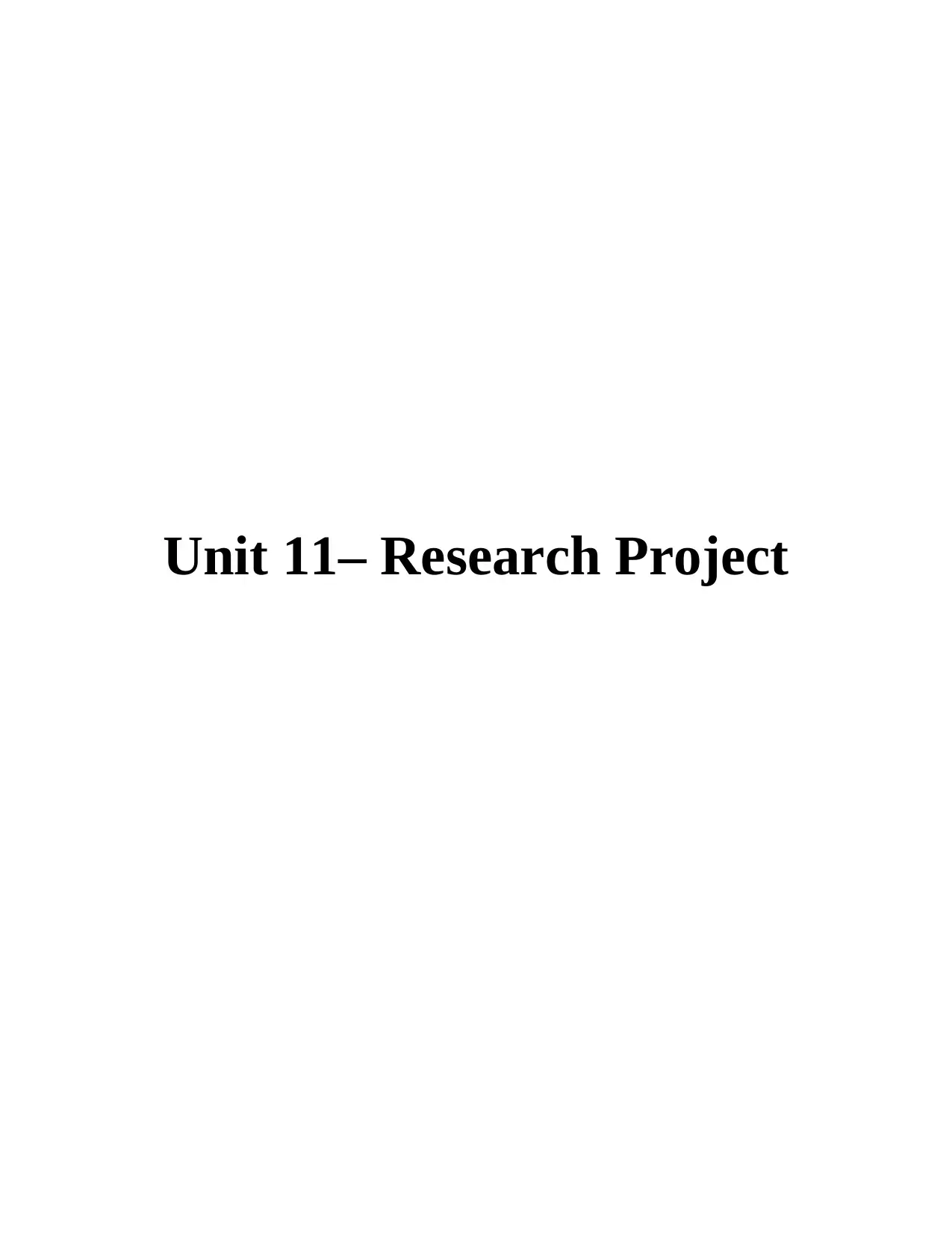
Unit 11– Research Project
Paraphrase This Document
Need a fresh take? Get an instant paraphrase of this document with our AI Paraphraser
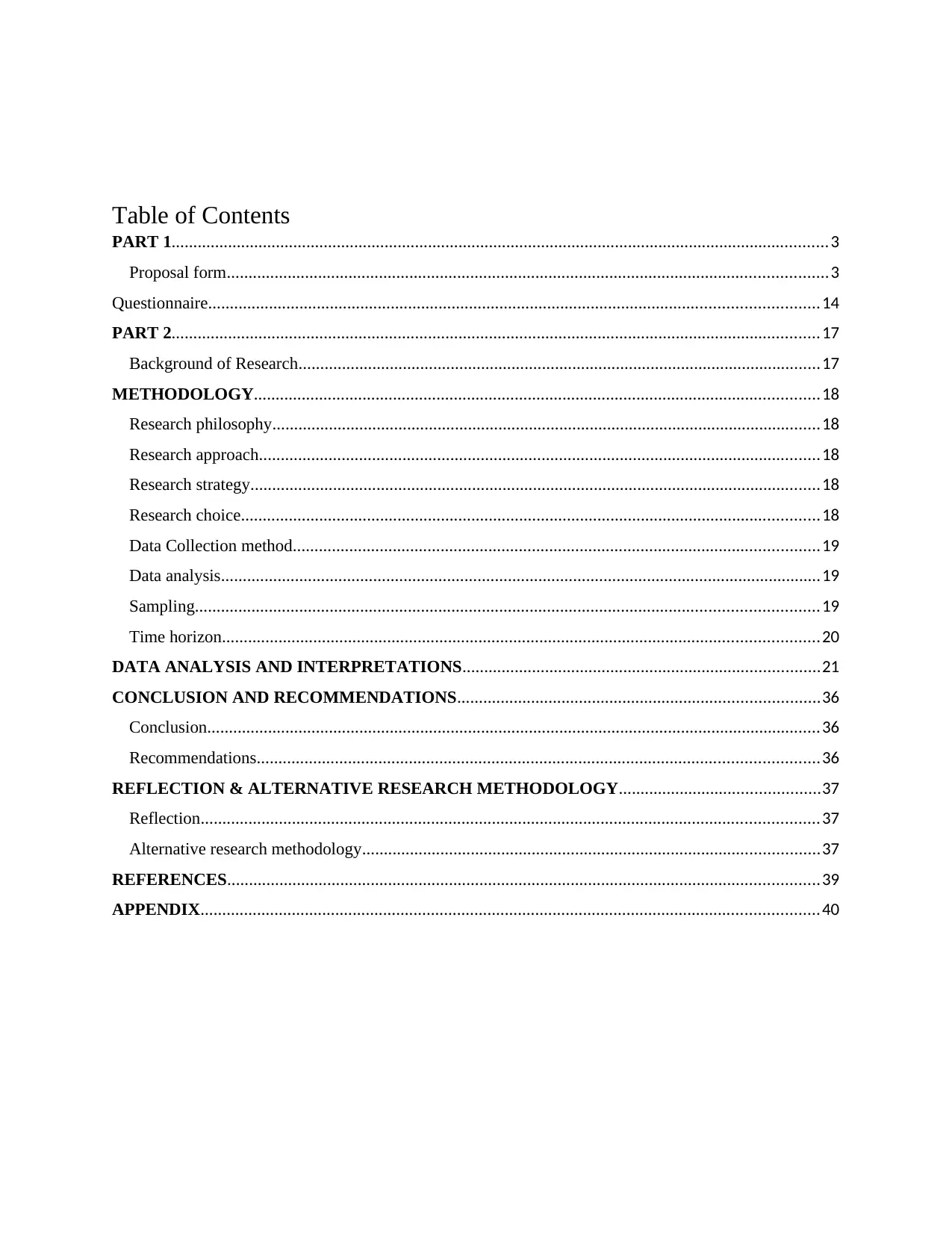
Table of Contents
PART 1.......................................................................................................................................................3
Proposal form..........................................................................................................................................3
Questionnaire............................................................................................................................................14
PART 2.....................................................................................................................................................17
Background of Research........................................................................................................................17
METHODOLOGY..................................................................................................................................18
Research philosophy..............................................................................................................................18
Research approach.................................................................................................................................18
Research strategy...................................................................................................................................18
Research choice.....................................................................................................................................18
Data Collection method.........................................................................................................................19
Data analysis..........................................................................................................................................19
Sampling...............................................................................................................................................19
Time horizon.........................................................................................................................................20
DATA ANALYSIS AND INTERPRETATIONS..................................................................................21
CONCLUSION AND RECOMMENDATIONS...................................................................................36
Conclusion.............................................................................................................................................36
Recommendations.................................................................................................................................36
REFLECTION & ALTERNATIVE RESEARCH METHODOLOGY..............................................37
Reflection..............................................................................................................................................37
Alternative research methodology.........................................................................................................37
REFERENCES........................................................................................................................................39
APPENDIX..............................................................................................................................................40
PART 1.......................................................................................................................................................3
Proposal form..........................................................................................................................................3
Questionnaire............................................................................................................................................14
PART 2.....................................................................................................................................................17
Background of Research........................................................................................................................17
METHODOLOGY..................................................................................................................................18
Research philosophy..............................................................................................................................18
Research approach.................................................................................................................................18
Research strategy...................................................................................................................................18
Research choice.....................................................................................................................................18
Data Collection method.........................................................................................................................19
Data analysis..........................................................................................................................................19
Sampling...............................................................................................................................................19
Time horizon.........................................................................................................................................20
DATA ANALYSIS AND INTERPRETATIONS..................................................................................21
CONCLUSION AND RECOMMENDATIONS...................................................................................36
Conclusion.............................................................................................................................................36
Recommendations.................................................................................................................................36
REFLECTION & ALTERNATIVE RESEARCH METHODOLOGY..............................................37
Reflection..............................................................................................................................................37
Alternative research methodology.........................................................................................................37
REFERENCES........................................................................................................................................39
APPENDIX..............................................................................................................................................40
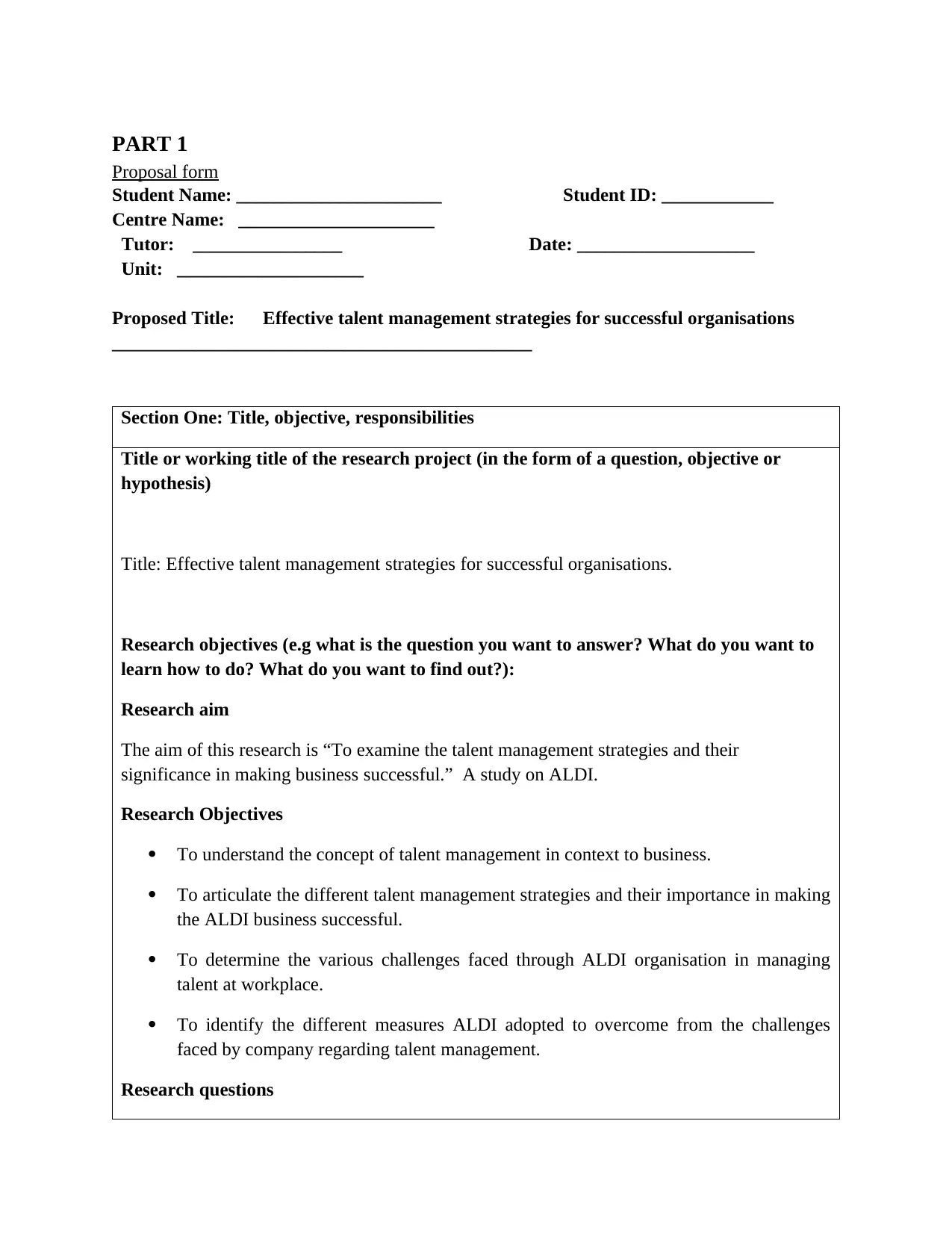
PART 1
Proposal form
Student Name: ______________________ Student ID: ____________
Centre Name: _____________________
Tutor: ________________ Date: ___________________
Unit: ____________________
Proposed Title: Effective talent management strategies for successful organisations
_____________________________________________
Section One: Title, objective, responsibilities
Title or working title of the research project (in the form of a question, objective or
hypothesis)
Title: Effective talent management strategies for successful organisations.
Research objectives (e.g what is the question you want to answer? What do you want to
learn how to do? What do you want to find out?):
Research aim
The aim of this research is “To examine the talent management strategies and their
significance in making business successful.” A study on ALDI.
Research Objectives
To understand the concept of talent management in context to business.
To articulate the different talent management strategies and their importance in making
the ALDI business successful.
To determine the various challenges faced through ALDI organisation in managing
talent at workplace.
To identify the different measures ALDI adopted to overcome from the challenges
faced by company regarding talent management.
Research questions
Proposal form
Student Name: ______________________ Student ID: ____________
Centre Name: _____________________
Tutor: ________________ Date: ___________________
Unit: ____________________
Proposed Title: Effective talent management strategies for successful organisations
_____________________________________________
Section One: Title, objective, responsibilities
Title or working title of the research project (in the form of a question, objective or
hypothesis)
Title: Effective talent management strategies for successful organisations.
Research objectives (e.g what is the question you want to answer? What do you want to
learn how to do? What do you want to find out?):
Research aim
The aim of this research is “To examine the talent management strategies and their
significance in making business successful.” A study on ALDI.
Research Objectives
To understand the concept of talent management in context to business.
To articulate the different talent management strategies and their importance in making
the ALDI business successful.
To determine the various challenges faced through ALDI organisation in managing
talent at workplace.
To identify the different measures ALDI adopted to overcome from the challenges
faced by company regarding talent management.
Research questions
⊘ This is a preview!⊘
Do you want full access?
Subscribe today to unlock all pages.

Trusted by 1+ million students worldwide
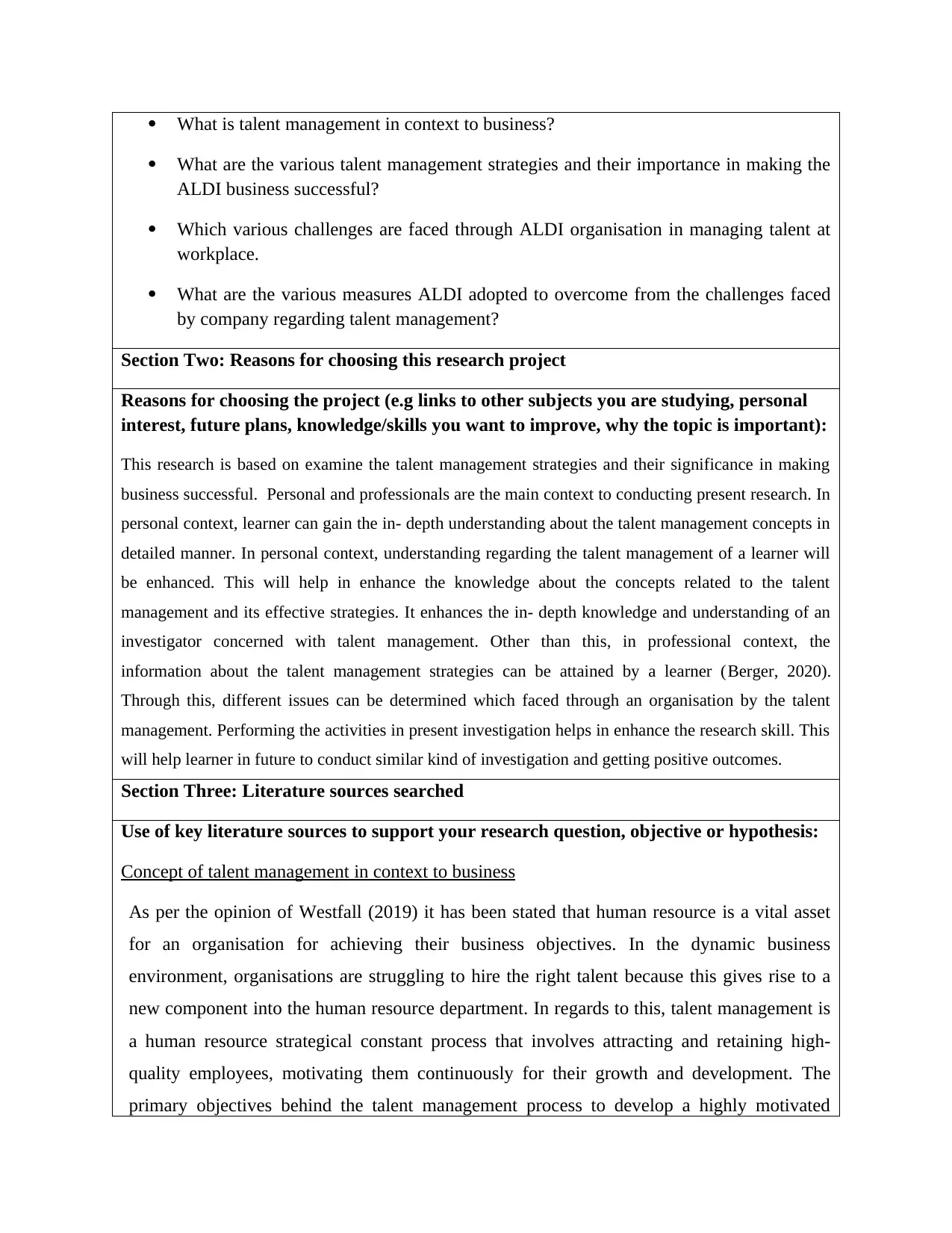
What is talent management in context to business?
What are the various talent management strategies and their importance in making the
ALDI business successful?
Which various challenges are faced through ALDI organisation in managing talent at
workplace.
What are the various measures ALDI adopted to overcome from the challenges faced
by company regarding talent management?
Section Two: Reasons for choosing this research project
Reasons for choosing the project (e.g links to other subjects you are studying, personal
interest, future plans, knowledge/skills you want to improve, why the topic is important):
This research is based on examine the talent management strategies and their significance in making
business successful. Personal and professionals are the main context to conducting present research. In
personal context, learner can gain the in- depth understanding about the talent management concepts in
detailed manner. In personal context, understanding regarding the talent management of a learner will
be enhanced. This will help in enhance the knowledge about the concepts related to the talent
management and its effective strategies. It enhances the in- depth knowledge and understanding of an
investigator concerned with talent management. Other than this, in professional context, the
information about the talent management strategies can be attained by a learner (Berger, 2020).
Through this, different issues can be determined which faced through an organisation by the talent
management. Performing the activities in present investigation helps in enhance the research skill. This
will help learner in future to conduct similar kind of investigation and getting positive outcomes.
Section Three: Literature sources searched
Use of key literature sources to support your research question, objective or hypothesis:
Concept of talent management in context to business
As per the opinion of Westfall (2019) it has been stated that human resource is a vital asset
for an organisation for achieving their business objectives. In the dynamic business
environment, organisations are struggling to hire the right talent because this gives rise to a
new component into the human resource department. In regards to this, talent management is
a human resource strategical constant process that involves attracting and retaining high-
quality employees, motivating them continuously for their growth and development. The
primary objectives behind the talent management process to develop a highly motivated
What are the various talent management strategies and their importance in making the
ALDI business successful?
Which various challenges are faced through ALDI organisation in managing talent at
workplace.
What are the various measures ALDI adopted to overcome from the challenges faced
by company regarding talent management?
Section Two: Reasons for choosing this research project
Reasons for choosing the project (e.g links to other subjects you are studying, personal
interest, future plans, knowledge/skills you want to improve, why the topic is important):
This research is based on examine the talent management strategies and their significance in making
business successful. Personal and professionals are the main context to conducting present research. In
personal context, learner can gain the in- depth understanding about the talent management concepts in
detailed manner. In personal context, understanding regarding the talent management of a learner will
be enhanced. This will help in enhance the knowledge about the concepts related to the talent
management and its effective strategies. It enhances the in- depth knowledge and understanding of an
investigator concerned with talent management. Other than this, in professional context, the
information about the talent management strategies can be attained by a learner (Berger, 2020).
Through this, different issues can be determined which faced through an organisation by the talent
management. Performing the activities in present investigation helps in enhance the research skill. This
will help learner in future to conduct similar kind of investigation and getting positive outcomes.
Section Three: Literature sources searched
Use of key literature sources to support your research question, objective or hypothesis:
Concept of talent management in context to business
As per the opinion of Westfall (2019) it has been stated that human resource is a vital asset
for an organisation for achieving their business objectives. In the dynamic business
environment, organisations are struggling to hire the right talent because this gives rise to a
new component into the human resource department. In regards to this, talent management is
a human resource strategical constant process that involves attracting and retaining high-
quality employees, motivating them continuously for their growth and development. The
primary objectives behind the talent management process to develop a highly motivated
Paraphrase This Document
Need a fresh take? Get an instant paraphrase of this document with our AI Paraphraser
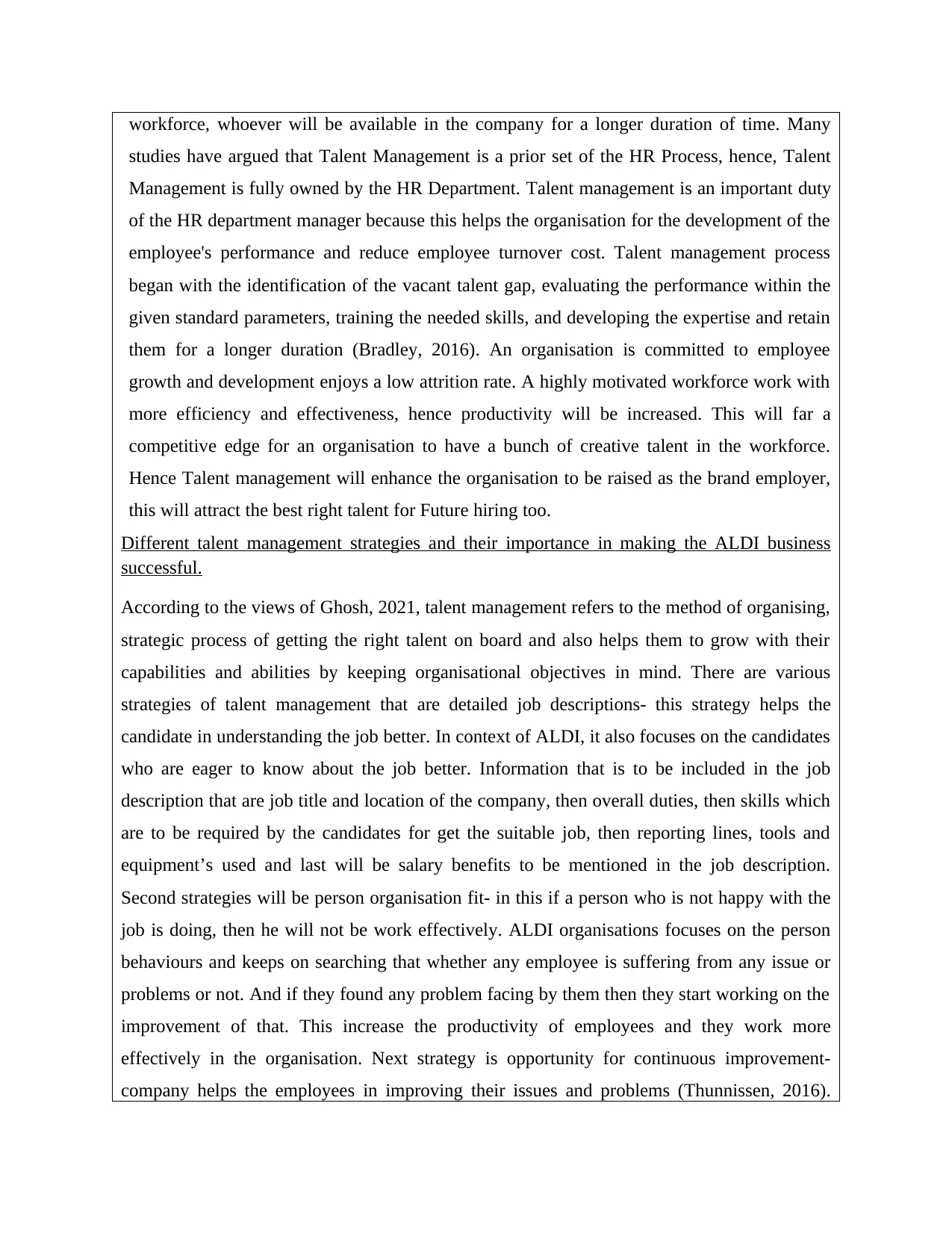
workforce, whoever will be available in the company for a longer duration of time. Many
studies have argued that Talent Management is a prior set of the HR Process, hence, Talent
Management is fully owned by the HR Department. Talent management is an important duty
of the HR department manager because this helps the organisation for the development of the
employee's performance and reduce employee turnover cost. Talent management process
began with the identification of the vacant talent gap, evaluating the performance within the
given standard parameters, training the needed skills, and developing the expertise and retain
them for a longer duration (Bradley, 2016). An organisation is committed to employee
growth and development enjoys a low attrition rate. A highly motivated workforce work with
more efficiency and effectiveness, hence productivity will be increased. This will far a
competitive edge for an organisation to have a bunch of creative talent in the workforce.
Hence Talent management will enhance the organisation to be raised as the brand employer,
this will attract the best right talent for Future hiring too.
Different talent management strategies and their importance in making the ALDI business
successful.
According to the views of Ghosh, 2021, talent management refers to the method of organising,
strategic process of getting the right talent on board and also helps them to grow with their
capabilities and abilities by keeping organisational objectives in mind. There are various
strategies of talent management that are detailed job descriptions- this strategy helps the
candidate in understanding the job better. In context of ALDI, it also focuses on the candidates
who are eager to know about the job better. Information that is to be included in the job
description that are job title and location of the company, then overall duties, then skills which
are to be required by the candidates for get the suitable job, then reporting lines, tools and
equipment’s used and last will be salary benefits to be mentioned in the job description.
Second strategies will be person organisation fit- in this if a person who is not happy with the
job is doing, then he will not be work effectively. ALDI organisations focuses on the person
behaviours and keeps on searching that whether any employee is suffering from any issue or
problems or not. And if they found any problem facing by them then they start working on the
improvement of that. This increase the productivity of employees and they work more
effectively in the organisation. Next strategy is opportunity for continuous improvement-
company helps the employees in improving their issues and problems (Thunnissen, 2016).
studies have argued that Talent Management is a prior set of the HR Process, hence, Talent
Management is fully owned by the HR Department. Talent management is an important duty
of the HR department manager because this helps the organisation for the development of the
employee's performance and reduce employee turnover cost. Talent management process
began with the identification of the vacant talent gap, evaluating the performance within the
given standard parameters, training the needed skills, and developing the expertise and retain
them for a longer duration (Bradley, 2016). An organisation is committed to employee
growth and development enjoys a low attrition rate. A highly motivated workforce work with
more efficiency and effectiveness, hence productivity will be increased. This will far a
competitive edge for an organisation to have a bunch of creative talent in the workforce.
Hence Talent management will enhance the organisation to be raised as the brand employer,
this will attract the best right talent for Future hiring too.
Different talent management strategies and their importance in making the ALDI business
successful.
According to the views of Ghosh, 2021, talent management refers to the method of organising,
strategic process of getting the right talent on board and also helps them to grow with their
capabilities and abilities by keeping organisational objectives in mind. There are various
strategies of talent management that are detailed job descriptions- this strategy helps the
candidate in understanding the job better. In context of ALDI, it also focuses on the candidates
who are eager to know about the job better. Information that is to be included in the job
description that are job title and location of the company, then overall duties, then skills which
are to be required by the candidates for get the suitable job, then reporting lines, tools and
equipment’s used and last will be salary benefits to be mentioned in the job description.
Second strategies will be person organisation fit- in this if a person who is not happy with the
job is doing, then he will not be work effectively. ALDI organisations focuses on the person
behaviours and keeps on searching that whether any employee is suffering from any issue or
problems or not. And if they found any problem facing by them then they start working on the
improvement of that. This increase the productivity of employees and they work more
effectively in the organisation. Next strategy is opportunity for continuous improvement-
company helps the employees in improving their issues and problems (Thunnissen, 2016).
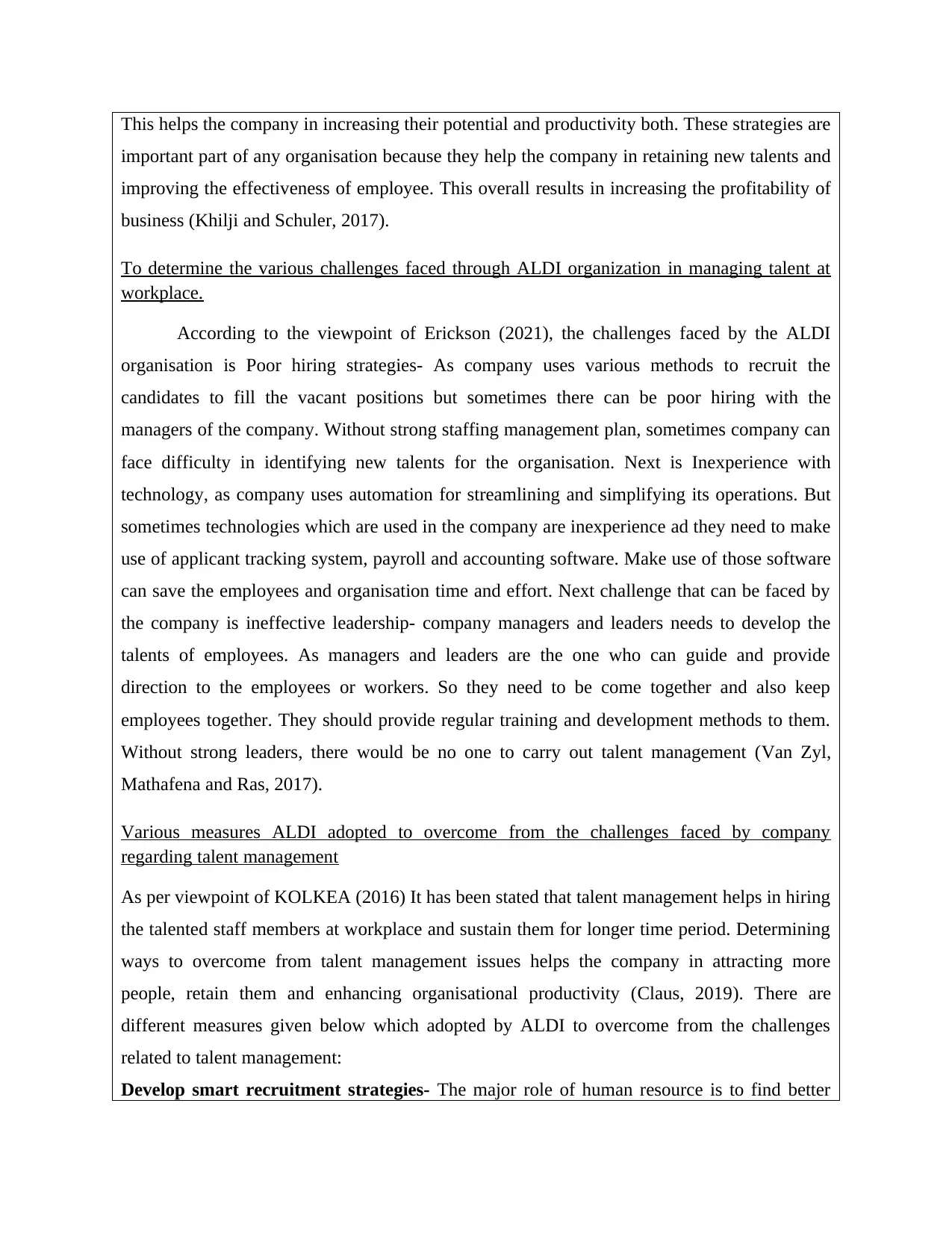
This helps the company in increasing their potential and productivity both. These strategies are
important part of any organisation because they help the company in retaining new talents and
improving the effectiveness of employee. This overall results in increasing the profitability of
business (Khilji and Schuler, 2017).
To determine the various challenges faced through ALDI organization in managing talent at
workplace.
According to the viewpoint of Erickson (2021), the challenges faced by the ALDI
organisation is Poor hiring strategies- As company uses various methods to recruit the
candidates to fill the vacant positions but sometimes there can be poor hiring with the
managers of the company. Without strong staffing management plan, sometimes company can
face difficulty in identifying new talents for the organisation. Next is Inexperience with
technology, as company uses automation for streamlining and simplifying its operations. But
sometimes technologies which are used in the company are inexperience ad they need to make
use of applicant tracking system, payroll and accounting software. Make use of those software
can save the employees and organisation time and effort. Next challenge that can be faced by
the company is ineffective leadership- company managers and leaders needs to develop the
talents of employees. As managers and leaders are the one who can guide and provide
direction to the employees or workers. So they need to be come together and also keep
employees together. They should provide regular training and development methods to them.
Without strong leaders, there would be no one to carry out talent management (Van Zyl,
Mathafena and Ras, 2017).
Various measures ALDI adopted to overcome from the challenges faced by company
regarding talent management
As per viewpoint of KOLKEA (2016) It has been stated that talent management helps in hiring
the talented staff members at workplace and sustain them for longer time period. Determining
ways to overcome from talent management issues helps the company in attracting more
people, retain them and enhancing organisational productivity (Claus, 2019). There are
different measures given below which adopted by ALDI to overcome from the challenges
related to talent management:
Develop smart recruitment strategies- The major role of human resource is to find better
important part of any organisation because they help the company in retaining new talents and
improving the effectiveness of employee. This overall results in increasing the profitability of
business (Khilji and Schuler, 2017).
To determine the various challenges faced through ALDI organization in managing talent at
workplace.
According to the viewpoint of Erickson (2021), the challenges faced by the ALDI
organisation is Poor hiring strategies- As company uses various methods to recruit the
candidates to fill the vacant positions but sometimes there can be poor hiring with the
managers of the company. Without strong staffing management plan, sometimes company can
face difficulty in identifying new talents for the organisation. Next is Inexperience with
technology, as company uses automation for streamlining and simplifying its operations. But
sometimes technologies which are used in the company are inexperience ad they need to make
use of applicant tracking system, payroll and accounting software. Make use of those software
can save the employees and organisation time and effort. Next challenge that can be faced by
the company is ineffective leadership- company managers and leaders needs to develop the
talents of employees. As managers and leaders are the one who can guide and provide
direction to the employees or workers. So they need to be come together and also keep
employees together. They should provide regular training and development methods to them.
Without strong leaders, there would be no one to carry out talent management (Van Zyl,
Mathafena and Ras, 2017).
Various measures ALDI adopted to overcome from the challenges faced by company
regarding talent management
As per viewpoint of KOLKEA (2016) It has been stated that talent management helps in hiring
the talented staff members at workplace and sustain them for longer time period. Determining
ways to overcome from talent management issues helps the company in attracting more
people, retain them and enhancing organisational productivity (Claus, 2019). There are
different measures given below which adopted by ALDI to overcome from the challenges
related to talent management:
Develop smart recruitment strategies- The major role of human resource is to find better
⊘ This is a preview!⊘
Do you want full access?
Subscribe today to unlock all pages.

Trusted by 1+ million students worldwide
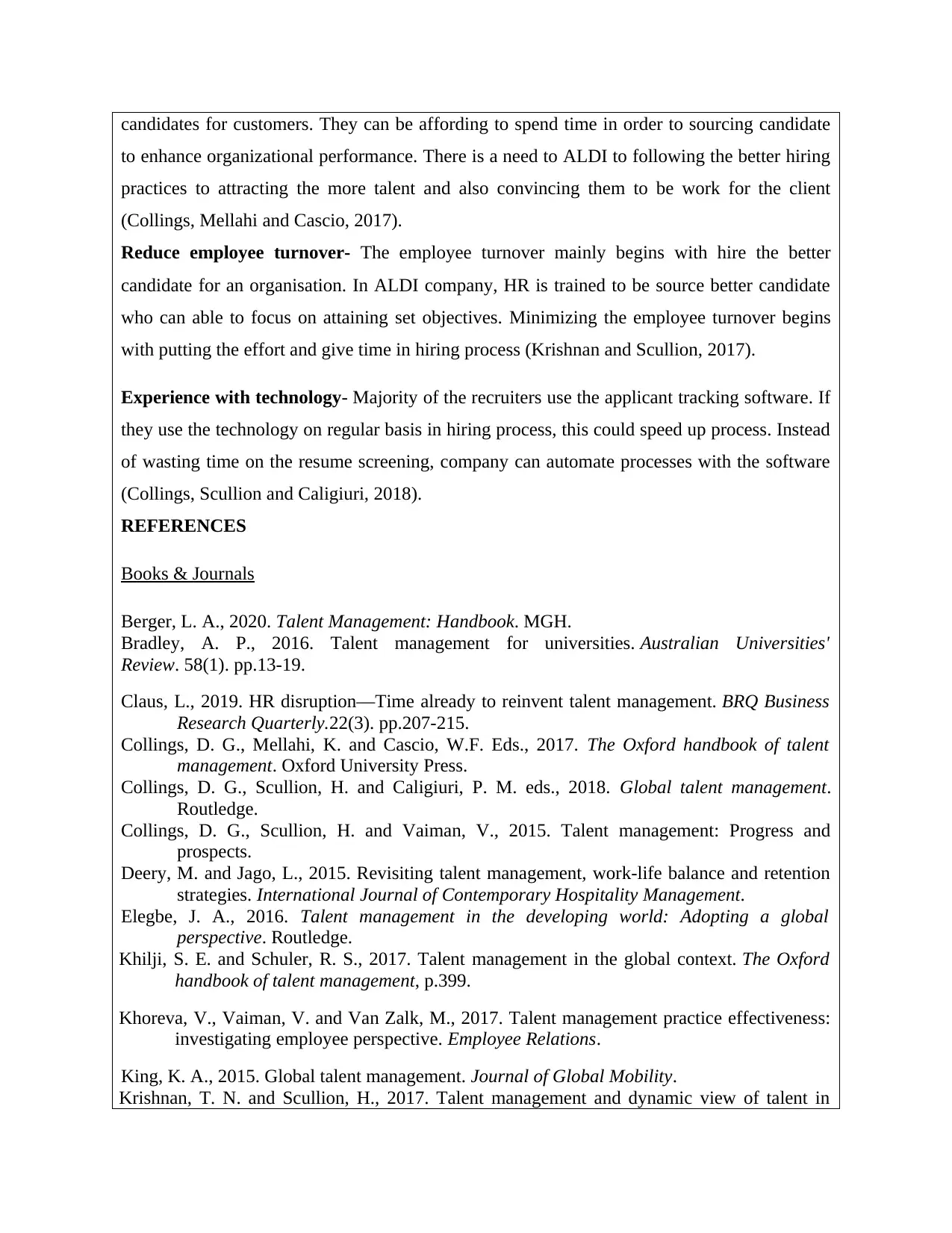
candidates for customers. They can be affording to spend time in order to sourcing candidate
to enhance organizational performance. There is a need to ALDI to following the better hiring
practices to attracting the more talent and also convincing them to be work for the client
(Collings, Mellahi and Cascio, 2017).
Reduce employee turnover- The employee turnover mainly begins with hire the better
candidate for an organisation. In ALDI company, HR is trained to be source better candidate
who can able to focus on attaining set objectives. Minimizing the employee turnover begins
with putting the effort and give time in hiring process (Krishnan and Scullion, 2017).
Experience with technology- Majority of the recruiters use the applicant tracking software. If
they use the technology on regular basis in hiring process, this could speed up process. Instead
of wasting time on the resume screening, company can automate processes with the software
(Collings, Scullion and Caligiuri, 2018).
REFERENCES
Books & Journals
Berger, L. A., 2020. Talent Management: Handbook. MGH.
Bradley, A. P., 2016. Talent management for universities. Australian Universities'
Review. 58(1). pp.13-19.
Claus, L., 2019. HR disruption—Time already to reinvent talent management. BRQ Business
Research Quarterly.22(3). pp.207-215.
Collings, D. G., Mellahi, K. and Cascio, W.F. Eds., 2017. The Oxford handbook of talent
management. Oxford University Press.
Collings, D. G., Scullion, H. and Caligiuri, P. M. eds., 2018. Global talent management.
Routledge.
Collings, D. G., Scullion, H. and Vaiman, V., 2015. Talent management: Progress and
prospects.
Deery, M. and Jago, L., 2015. Revisiting talent management, work-life balance and retention
strategies. International Journal of Contemporary Hospitality Management.
Elegbe, J. A., 2016. Talent management in the developing world: Adopting a global
perspective. Routledge.
Khilji, S. E. and Schuler, R. S., 2017. Talent management in the global context. The Oxford
handbook of talent management, p.399.
Khoreva, V., Vaiman, V. and Van Zalk, M., 2017. Talent management practice effectiveness:
investigating employee perspective. Employee Relations.
King, K. A., 2015. Global talent management. Journal of Global Mobility.
Krishnan, T. N. and Scullion, H., 2017. Talent management and dynamic view of talent in
to enhance organizational performance. There is a need to ALDI to following the better hiring
practices to attracting the more talent and also convincing them to be work for the client
(Collings, Mellahi and Cascio, 2017).
Reduce employee turnover- The employee turnover mainly begins with hire the better
candidate for an organisation. In ALDI company, HR is trained to be source better candidate
who can able to focus on attaining set objectives. Minimizing the employee turnover begins
with putting the effort and give time in hiring process (Krishnan and Scullion, 2017).
Experience with technology- Majority of the recruiters use the applicant tracking software. If
they use the technology on regular basis in hiring process, this could speed up process. Instead
of wasting time on the resume screening, company can automate processes with the software
(Collings, Scullion and Caligiuri, 2018).
REFERENCES
Books & Journals
Berger, L. A., 2020. Talent Management: Handbook. MGH.
Bradley, A. P., 2016. Talent management for universities. Australian Universities'
Review. 58(1). pp.13-19.
Claus, L., 2019. HR disruption—Time already to reinvent talent management. BRQ Business
Research Quarterly.22(3). pp.207-215.
Collings, D. G., Mellahi, K. and Cascio, W.F. Eds., 2017. The Oxford handbook of talent
management. Oxford University Press.
Collings, D. G., Scullion, H. and Caligiuri, P. M. eds., 2018. Global talent management.
Routledge.
Collings, D. G., Scullion, H. and Vaiman, V., 2015. Talent management: Progress and
prospects.
Deery, M. and Jago, L., 2015. Revisiting talent management, work-life balance and retention
strategies. International Journal of Contemporary Hospitality Management.
Elegbe, J. A., 2016. Talent management in the developing world: Adopting a global
perspective. Routledge.
Khilji, S. E. and Schuler, R. S., 2017. Talent management in the global context. The Oxford
handbook of talent management, p.399.
Khoreva, V., Vaiman, V. and Van Zalk, M., 2017. Talent management practice effectiveness:
investigating employee perspective. Employee Relations.
King, K. A., 2015. Global talent management. Journal of Global Mobility.
Krishnan, T. N. and Scullion, H., 2017. Talent management and dynamic view of talent in
Paraphrase This Document
Need a fresh take? Get an instant paraphrase of this document with our AI Paraphraser
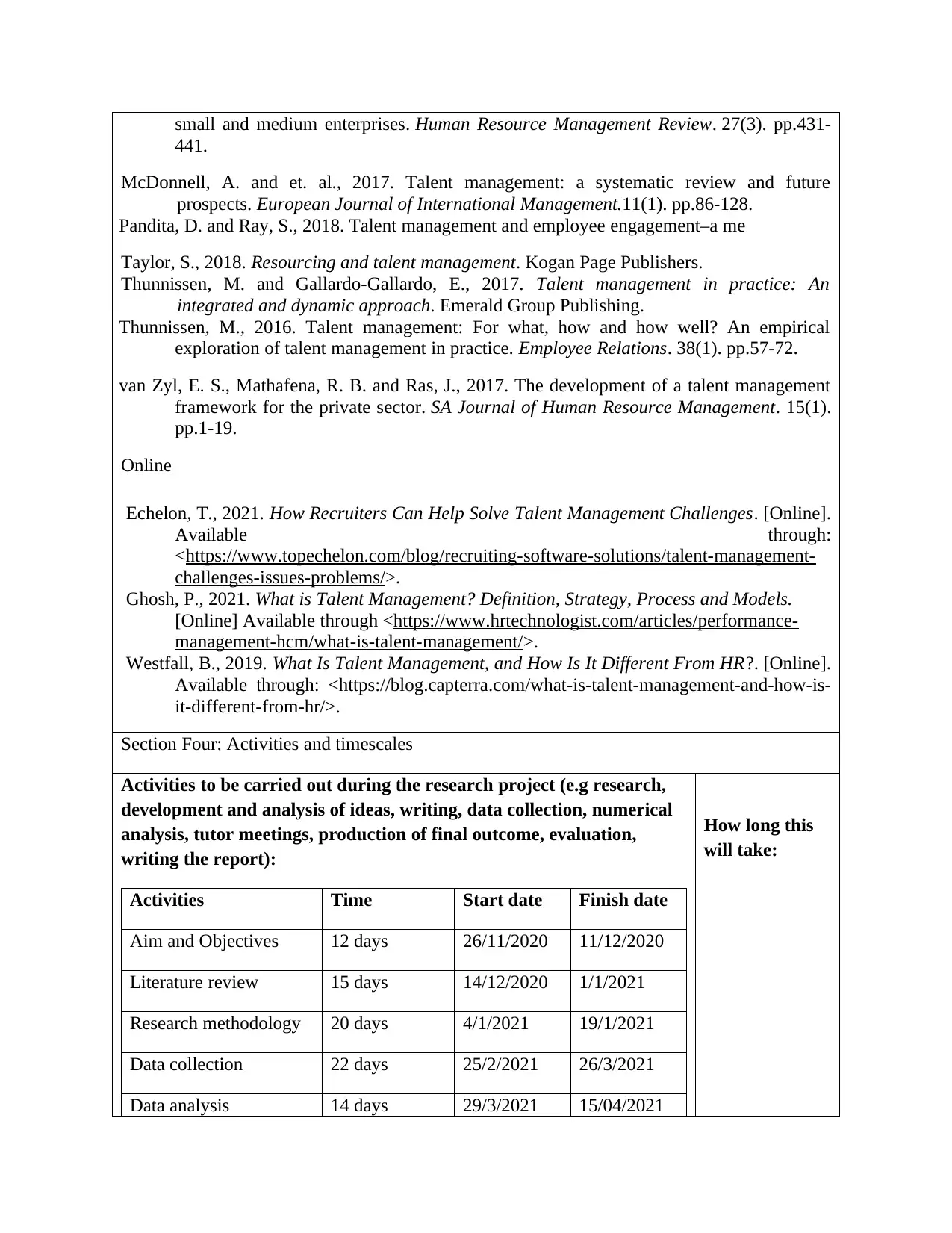
small and medium enterprises. Human Resource Management Review. 27(3). pp.431-
441.
McDonnell, A. and et. al., 2017. Talent management: a systematic review and future
prospects. European Journal of International Management.11(1). pp.86-128.
Pandita, D. and Ray, S., 2018. Talent management and employee engagement–a me
Taylor, S., 2018. Resourcing and talent management. Kogan Page Publishers.
Thunnissen, M. and Gallardo-Gallardo, E., 2017. Talent management in practice: An
integrated and dynamic approach. Emerald Group Publishing.
Thunnissen, M., 2016. Talent management: For what, how and how well? An empirical
exploration of talent management in practice. Employee Relations. 38(1). pp.57-72.
van Zyl, E. S., Mathafena, R. B. and Ras, J., 2017. The development of a talent management
framework for the private sector. SA Journal of Human Resource Management. 15(1).
pp.1-19.
Online
Echelon, T., 2021. How Recruiters Can Help Solve Talent Management Challenges. [Online].
Available through:
<https://www.topechelon.com/blog/recruiting-software-solutions/talent-management-
challenges-issues-problems/>.
Ghosh, P., 2021. What is Talent Management? Definition, Strategy, Process and Models.
[Online] Available through <https://www.hrtechnologist.com/articles/performance-
management-hcm/what-is-talent-management/>.
Westfall, B., 2019. What Is Talent Management, and How Is It Different From HR?. [Online].
Available through: <https://blog.capterra.com/what-is-talent-management-and-how-is-
it-different-from-hr/>.
Section Four: Activities and timescales
Activities to be carried out during the research project (e.g research,
development and analysis of ideas, writing, data collection, numerical
analysis, tutor meetings, production of final outcome, evaluation,
writing the report):
Activities Time Start date Finish date
Aim and Objectives 12 days 26/11/2020 11/12/2020
Literature review 15 days 14/12/2020 1/1/2021
Research methodology 20 days 4/1/2021 19/1/2021
Data collection 22 days 25/2/2021 26/3/2021
Data analysis 14 days 29/3/2021 15/04/2021
How long this
will take:
441.
McDonnell, A. and et. al., 2017. Talent management: a systematic review and future
prospects. European Journal of International Management.11(1). pp.86-128.
Pandita, D. and Ray, S., 2018. Talent management and employee engagement–a me
Taylor, S., 2018. Resourcing and talent management. Kogan Page Publishers.
Thunnissen, M. and Gallardo-Gallardo, E., 2017. Talent management in practice: An
integrated and dynamic approach. Emerald Group Publishing.
Thunnissen, M., 2016. Talent management: For what, how and how well? An empirical
exploration of talent management in practice. Employee Relations. 38(1). pp.57-72.
van Zyl, E. S., Mathafena, R. B. and Ras, J., 2017. The development of a talent management
framework for the private sector. SA Journal of Human Resource Management. 15(1).
pp.1-19.
Online
Echelon, T., 2021. How Recruiters Can Help Solve Talent Management Challenges. [Online].
Available through:
<https://www.topechelon.com/blog/recruiting-software-solutions/talent-management-
challenges-issues-problems/>.
Ghosh, P., 2021. What is Talent Management? Definition, Strategy, Process and Models.
[Online] Available through <https://www.hrtechnologist.com/articles/performance-
management-hcm/what-is-talent-management/>.
Westfall, B., 2019. What Is Talent Management, and How Is It Different From HR?. [Online].
Available through: <https://blog.capterra.com/what-is-talent-management-and-how-is-
it-different-from-hr/>.
Section Four: Activities and timescales
Activities to be carried out during the research project (e.g research,
development and analysis of ideas, writing, data collection, numerical
analysis, tutor meetings, production of final outcome, evaluation,
writing the report):
Activities Time Start date Finish date
Aim and Objectives 12 days 26/11/2020 11/12/2020
Literature review 15 days 14/12/2020 1/1/2021
Research methodology 20 days 4/1/2021 19/1/2021
Data collection 22 days 25/2/2021 26/3/2021
Data analysis 14 days 29/3/2021 15/04/2021
How long this
will take:
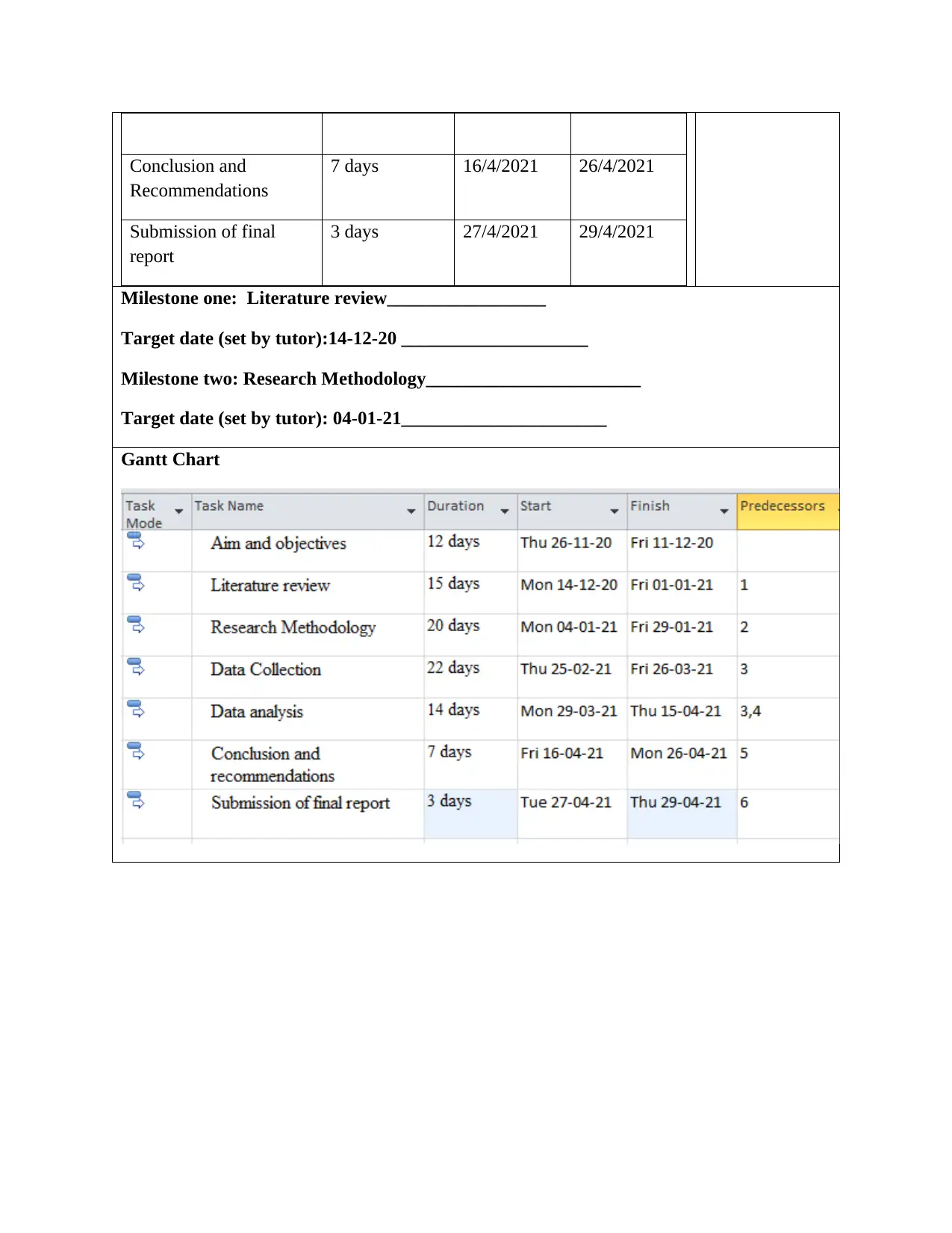
Conclusion and
Recommendations
7 days 16/4/2021 26/4/2021
Submission of final
report
3 days 27/4/2021 29/4/2021
Milestone one: Literature review_________________
Target date (set by tutor):14-12-20 ____________________
Milestone two: Research Methodology_______________________
Target date (set by tutor): 04-01-21______________________
Gantt Chart
Recommendations
7 days 16/4/2021 26/4/2021
Submission of final
report
3 days 27/4/2021 29/4/2021
Milestone one: Literature review_________________
Target date (set by tutor):14-12-20 ____________________
Milestone two: Research Methodology_______________________
Target date (set by tutor): 04-01-21______________________
Gantt Chart
⊘ This is a preview!⊘
Do you want full access?
Subscribe today to unlock all pages.

Trusted by 1+ million students worldwide
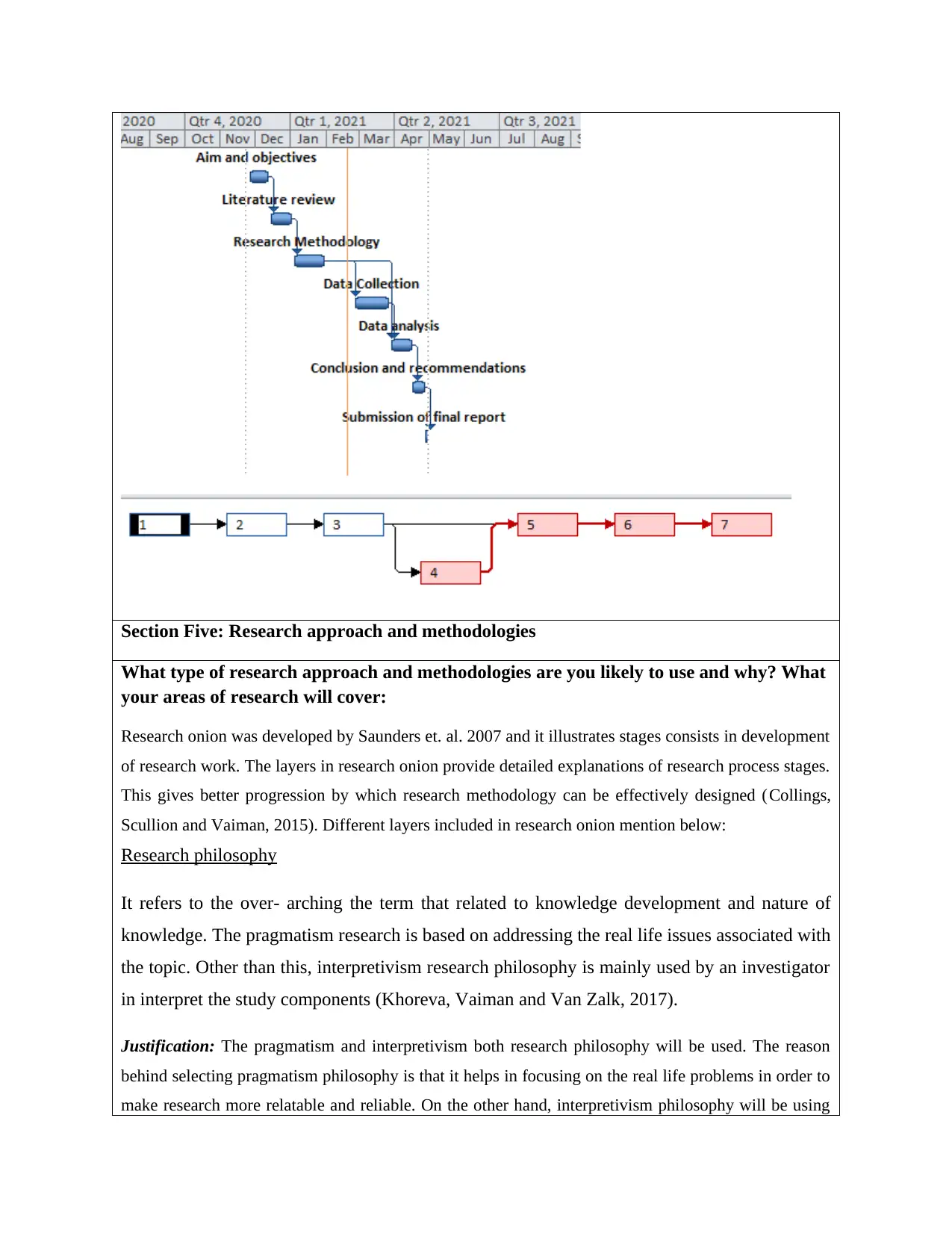
Section Five: Research approach and methodologies
What type of research approach and methodologies are you likely to use and why? What
your areas of research will cover:
Research onion was developed by Saunders et. al. 2007 and it illustrates stages consists in development
of research work. The layers in research onion provide detailed explanations of research process stages.
This gives better progression by which research methodology can be effectively designed (Collings,
Scullion and Vaiman, 2015). Different layers included in research onion mention below:
Research philosophy
It refers to the over- arching the term that related to knowledge development and nature of
knowledge. The pragmatism research is based on addressing the real life issues associated with
the topic. Other than this, interpretivism research philosophy is mainly used by an investigator
in interpret the study components (Khoreva, Vaiman and Van Zalk, 2017).
Justification: The pragmatism and interpretivism both research philosophy will be used. The reason
behind selecting pragmatism philosophy is that it helps in focusing on the real life problems in order to
make research more relatable and reliable. On the other hand, interpretivism philosophy will be using
What type of research approach and methodologies are you likely to use and why? What
your areas of research will cover:
Research onion was developed by Saunders et. al. 2007 and it illustrates stages consists in development
of research work. The layers in research onion provide detailed explanations of research process stages.
This gives better progression by which research methodology can be effectively designed (Collings,
Scullion and Vaiman, 2015). Different layers included in research onion mention below:
Research philosophy
It refers to the over- arching the term that related to knowledge development and nature of
knowledge. The pragmatism research is based on addressing the real life issues associated with
the topic. Other than this, interpretivism research philosophy is mainly used by an investigator
in interpret the study components (Khoreva, Vaiman and Van Zalk, 2017).
Justification: The pragmatism and interpretivism both research philosophy will be used. The reason
behind selecting pragmatism philosophy is that it helps in focusing on the real life problems in order to
make research more relatable and reliable. On the other hand, interpretivism philosophy will be using
Paraphrase This Document
Need a fresh take? Get an instant paraphrase of this document with our AI Paraphraser
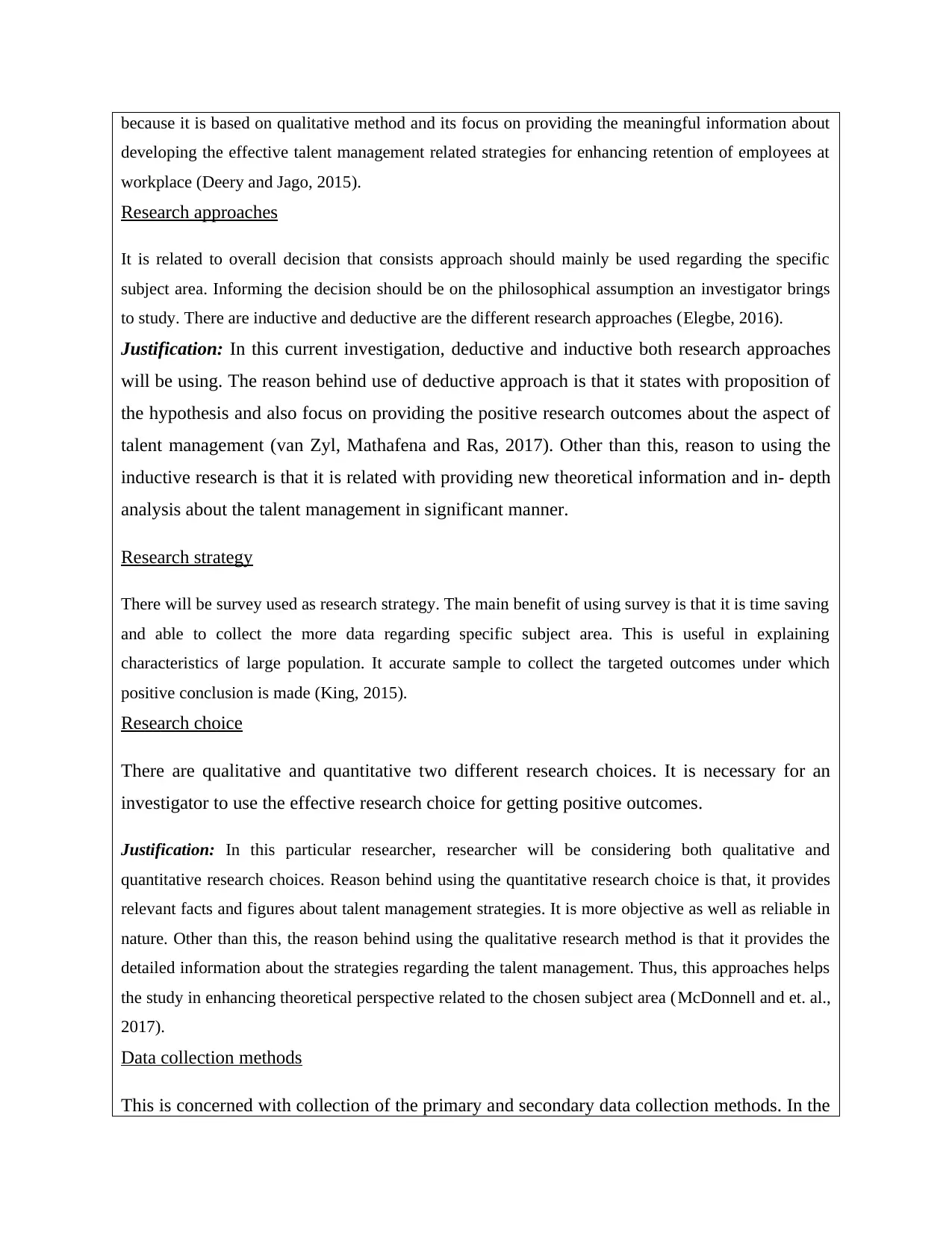
because it is based on qualitative method and its focus on providing the meaningful information about
developing the effective talent management related strategies for enhancing retention of employees at
workplace (Deery and Jago, 2015).
Research approaches
It is related to overall decision that consists approach should mainly be used regarding the specific
subject area. Informing the decision should be on the philosophical assumption an investigator brings
to study. There are inductive and deductive are the different research approaches (Elegbe, 2016).
Justification: In this current investigation, deductive and inductive both research approaches
will be using. The reason behind use of deductive approach is that it states with proposition of
the hypothesis and also focus on providing the positive research outcomes about the aspect of
talent management (van Zyl, Mathafena and Ras, 2017). Other than this, reason to using the
inductive research is that it is related with providing new theoretical information and in- depth
analysis about the talent management in significant manner.
Research strategy
There will be survey used as research strategy. The main benefit of using survey is that it is time saving
and able to collect the more data regarding specific subject area. This is useful in explaining
characteristics of large population. It accurate sample to collect the targeted outcomes under which
positive conclusion is made (King, 2015).
Research choice
There are qualitative and quantitative two different research choices. It is necessary for an
investigator to use the effective research choice for getting positive outcomes.
Justification: In this particular researcher, researcher will be considering both qualitative and
quantitative research choices. Reason behind using the quantitative research choice is that, it provides
relevant facts and figures about talent management strategies. It is more objective as well as reliable in
nature. Other than this, the reason behind using the qualitative research method is that it provides the
detailed information about the strategies regarding the talent management. Thus, this approaches helps
the study in enhancing theoretical perspective related to the chosen subject area (McDonnell and et. al.,
2017).
Data collection methods
This is concerned with collection of the primary and secondary data collection methods. In the
developing the effective talent management related strategies for enhancing retention of employees at
workplace (Deery and Jago, 2015).
Research approaches
It is related to overall decision that consists approach should mainly be used regarding the specific
subject area. Informing the decision should be on the philosophical assumption an investigator brings
to study. There are inductive and deductive are the different research approaches (Elegbe, 2016).
Justification: In this current investigation, deductive and inductive both research approaches
will be using. The reason behind use of deductive approach is that it states with proposition of
the hypothesis and also focus on providing the positive research outcomes about the aspect of
talent management (van Zyl, Mathafena and Ras, 2017). Other than this, reason to using the
inductive research is that it is related with providing new theoretical information and in- depth
analysis about the talent management in significant manner.
Research strategy
There will be survey used as research strategy. The main benefit of using survey is that it is time saving
and able to collect the more data regarding specific subject area. This is useful in explaining
characteristics of large population. It accurate sample to collect the targeted outcomes under which
positive conclusion is made (King, 2015).
Research choice
There are qualitative and quantitative two different research choices. It is necessary for an
investigator to use the effective research choice for getting positive outcomes.
Justification: In this particular researcher, researcher will be considering both qualitative and
quantitative research choices. Reason behind using the quantitative research choice is that, it provides
relevant facts and figures about talent management strategies. It is more objective as well as reliable in
nature. Other than this, the reason behind using the qualitative research method is that it provides the
detailed information about the strategies regarding the talent management. Thus, this approaches helps
the study in enhancing theoretical perspective related to the chosen subject area (McDonnell and et. al.,
2017).
Data collection methods
This is concerned with collection of the primary and secondary data collection methods. In the
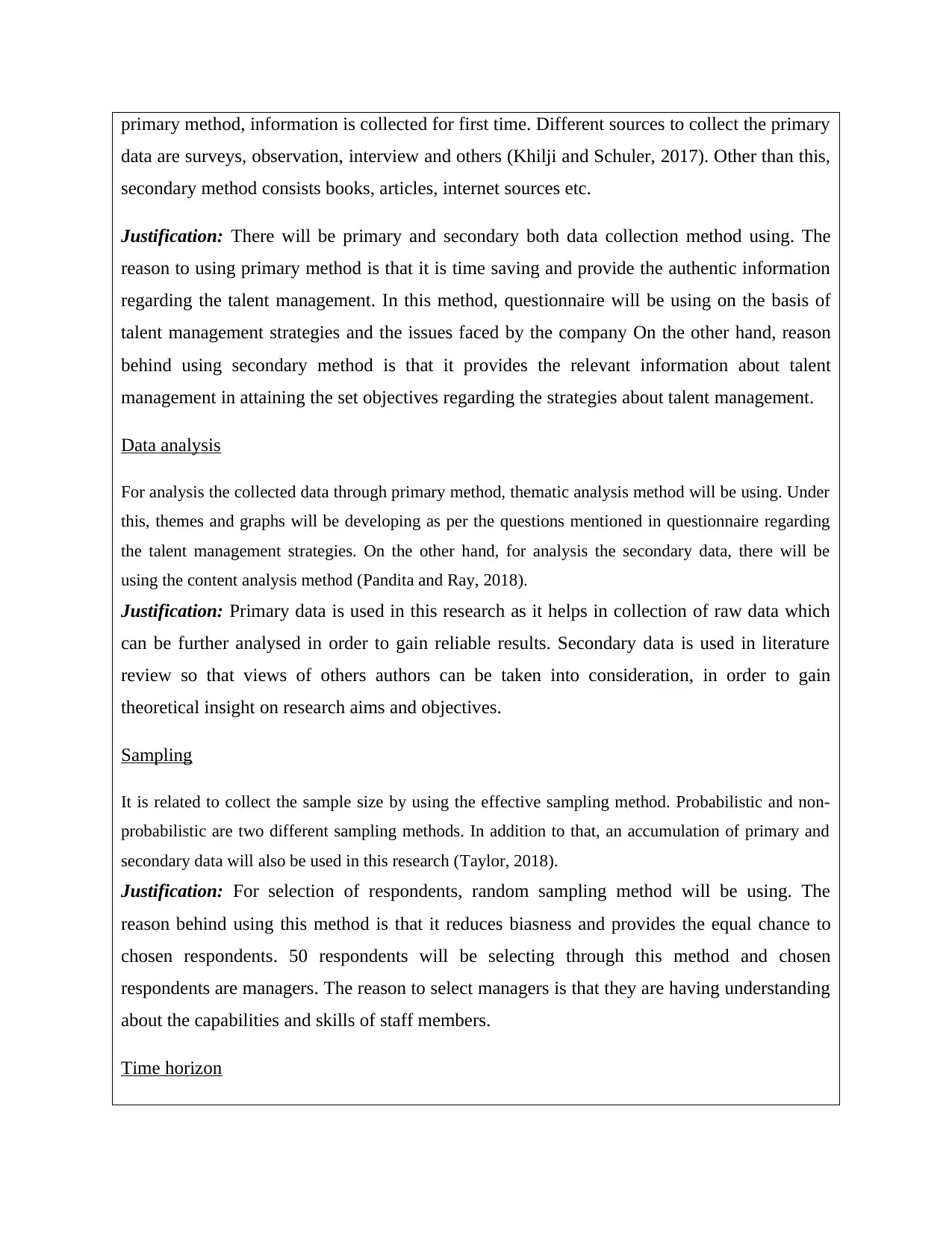
primary method, information is collected for first time. Different sources to collect the primary
data are surveys, observation, interview and others (Khilji and Schuler, 2017). Other than this,
secondary method consists books, articles, internet sources etc.
Justification: There will be primary and secondary both data collection method using. The
reason to using primary method is that it is time saving and provide the authentic information
regarding the talent management. In this method, questionnaire will be using on the basis of
talent management strategies and the issues faced by the company On the other hand, reason
behind using secondary method is that it provides the relevant information about talent
management in attaining the set objectives regarding the strategies about talent management.
Data analysis
For analysis the collected data through primary method, thematic analysis method will be using. Under
this, themes and graphs will be developing as per the questions mentioned in questionnaire regarding
the talent management strategies. On the other hand, for analysis the secondary data, there will be
using the content analysis method (Pandita and Ray, 2018).
Justification: Primary data is used in this research as it helps in collection of raw data which
can be further analysed in order to gain reliable results. Secondary data is used in literature
review so that views of others authors can be taken into consideration, in order to gain
theoretical insight on research aims and objectives.
Sampling
It is related to collect the sample size by using the effective sampling method. Probabilistic and non-
probabilistic are two different sampling methods. In addition to that, an accumulation of primary and
secondary data will also be used in this research (Taylor, 2018).
Justification: For selection of respondents, random sampling method will be using. The
reason behind using this method is that it reduces biasness and provides the equal chance to
chosen respondents. 50 respondents will be selecting through this method and chosen
respondents are managers. The reason to select managers is that they are having understanding
about the capabilities and skills of staff members.
Time horizon
data are surveys, observation, interview and others (Khilji and Schuler, 2017). Other than this,
secondary method consists books, articles, internet sources etc.
Justification: There will be primary and secondary both data collection method using. The
reason to using primary method is that it is time saving and provide the authentic information
regarding the talent management. In this method, questionnaire will be using on the basis of
talent management strategies and the issues faced by the company On the other hand, reason
behind using secondary method is that it provides the relevant information about talent
management in attaining the set objectives regarding the strategies about talent management.
Data analysis
For analysis the collected data through primary method, thematic analysis method will be using. Under
this, themes and graphs will be developing as per the questions mentioned in questionnaire regarding
the talent management strategies. On the other hand, for analysis the secondary data, there will be
using the content analysis method (Pandita and Ray, 2018).
Justification: Primary data is used in this research as it helps in collection of raw data which
can be further analysed in order to gain reliable results. Secondary data is used in literature
review so that views of others authors can be taken into consideration, in order to gain
theoretical insight on research aims and objectives.
Sampling
It is related to collect the sample size by using the effective sampling method. Probabilistic and non-
probabilistic are two different sampling methods. In addition to that, an accumulation of primary and
secondary data will also be used in this research (Taylor, 2018).
Justification: For selection of respondents, random sampling method will be using. The
reason behind using this method is that it reduces biasness and provides the equal chance to
chosen respondents. 50 respondents will be selecting through this method and chosen
respondents are managers. The reason to select managers is that they are having understanding
about the capabilities and skills of staff members.
Time horizon
⊘ This is a preview!⊘
Do you want full access?
Subscribe today to unlock all pages.

Trusted by 1+ million students worldwide
1 out of 45
Related Documents
Your All-in-One AI-Powered Toolkit for Academic Success.
+13062052269
info@desklib.com
Available 24*7 on WhatsApp / Email
![[object Object]](/_next/static/media/star-bottom.7253800d.svg)
Unlock your academic potential
Copyright © 2020–2025 A2Z Services. All Rights Reserved. Developed and managed by ZUCOL.





